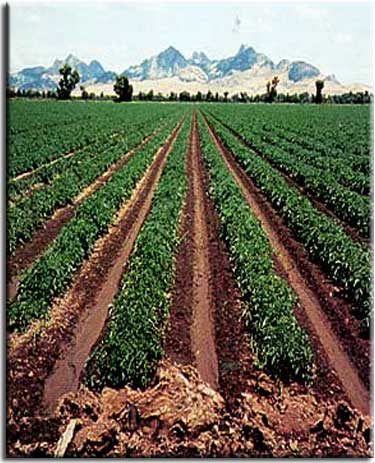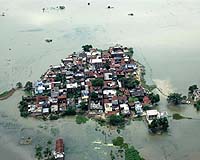Agriculture and climate change: A two-way interaction
 Agriculture – farming, grazing and the tending of orchards, vineyards and timberland – is one of humanity's greatest achievements. Its development around 10 000 years ago set the stage for our current civilization. Having a steady source of food aided in both our sociological and technological development. The vagaries of weather and climate have always been a threat to agriculture at any given time. Climate change presents an even greater danger. Even absent a changing climate bring more extreme weather, the signs are troubling.
Agriculture – farming, grazing and the tending of orchards, vineyards and timberland – is one of humanity's greatest achievements. Its development around 10 000 years ago set the stage for our current civilization. Having a steady source of food aided in both our sociological and technological development. The vagaries of weather and climate have always been a threat to agriculture at any given time. Climate change presents an even greater danger. Even absent a changing climate bring more extreme weather, the signs are troubling.
Some people worry about peak oil. I worry more about peak grain.
The fact is that world per capita cereal production has already passed its peak, which was back in the mid-Eighties, not least because of collapsing production in the former Soviet Union and sub-Saharan Africa. Simultaneously, however, rising incomes in Asia are causing a surge in worldwide food demand.
Already the symptoms of the coming food shortage are detectable. The International Monetary Fund recorded a 23 per cent rise in world food prices during the last 18 months. Maybe you've observed it yourself. I certainly have.
Of course, we're not supposed to notice that prices are going up. In the United States, the monetary authorities insist that we should focus on the "core" Consumer Price Index, which excludes the cost of food. According to that measure, the annual inflation rate in the US is just 2.2 per cent. But food inflation is roughly double that.
However, the spectre of climate change adds a new challenge.
Climate change with frequent droughts and floods is likely to cut food output and increase hunger risk in developing countries, the U.N food agency said on Tuesday, adding its voice to global warming concerns.
Even small global temperature rises would trigger crop declines and raise the risk of hunger at lower latitudes, especially in the seasonally dry tropics, said Jacques Diouf, director general of Food and Agriculture Organization (FAO).
"Rain-fed agriculture in marginal areas in semi-arid and sub-humid regions is mostly at risk," Diouf said in a statement after a conference in India.
"India could lose 125 million tonnes of its rain-fed cereal production -- equivalent to 18 percent of its total production," he said.
Flooding and other extreme weather, attributed to climate change by the World Meteorological Organization, has reached new heights thus far in 2007 (see here and just about any of the other posts on planet doom?). Global warming is already beginning to detrimentally affect agriculture worldwide. For example:
30-50% crop losses in parts of southeast Europe from extreme drought;
Nearly zero water allocation for irrigation in the Murray-Darling basin, Australia's 'bread basket';
Threats to Uganda's coffee crop, which brings in half of the country's revenue;
UN relief efforts in Africa can no longer afford the food to support famine-affected people; and
Millions of malnourished Indian children are vulnerable to disease after South Asia's worst floods in years.
Meeting the future demands required of agriculture requires careful planning.
Growing food and fiber entails the use of fertilizer and irrigation systems and results in land clearing. These 'side effects' of agriculture can lead to regime shifts--or 'tipping points' which include desertification, salinisation, water degradation, and changes in climate due to altered water flows from land to atmosphere.
As human populations shift to more meat-heavy diets, trade of agricultural products increases, and demand for biofuels grows, the pressure on agricultural systems is mounting. The challenge is to figure out how to meet these demands and keep the ecosystem functions that underpin productivity working
[...T]he mid-United States, the Amazon, the Sahel, India, and Northern China [are] the most likely areas to undergo climate change...
[...L]and use changes [are equivalent] to fuel emissions in their potential to drive climatic changes...local land cover changes may very likely generate changes elsewhere by altering the general circulation of the atmosphere.
The development of cropping systems resilient to extreme climatic conditions is a major challenge to farmers. USDA researchers have summarized their findings on the short-term effects of a variety of crop sequences in dynamic cropping systems.
Around the world, extreme climatic conditions are forcing farmers to rethink current cropping system strategies. To maximize crop production in the face of variable temperatures and precipitation, scientists say farmers may want to adopt a system in which crop sequencing decisions are based upon weather patterns and management goals each year. However, before making the change to a more adaptable cropping systems strategy, researchers say it’s important to understand how short-term crop sequencing decisions affect key agronomic and environmental attributes.
The impact of climate change on agriculture presents a serious threat. It is real, and is already beginning to be felt in many areas of the world. Careful planning and cooperation is required. Rash actions in land management could make the situation worse.
Afterword: For more on land use impacts and climate change, I recommend Roger Pielke Sr's blog, Climate Science. Though known as a skeptic's site, the main thrust isn't so much denial as it is the understated importance of land use changes on the climate.



No comments:
Post a Comment